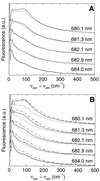The nature of the excited state of the reaction center of photosystem II of green plants: a high-resolution fluorescence spectroscopy study
- PMID: 9600929
- PMCID: PMC27597
- DOI: 10.1073/pnas.95.11.6128
The nature of the excited state of the reaction center of photosystem II of green plants: a high-resolution fluorescence spectroscopy study
Abstract
We studied the electronically excited state of the isolated reaction center of photosystem II with high-resolution fluorescence spectroscopy at 5 K and compared the obtained spectral features with those obtained earlier for the primary electron donor. The results show that there is a striking resemblance between the emitting and charge-separating states in the photosystem II reaction center, such as a very similar shape of the phonon wing with characteristic features at 19 and 80 cm-1, almost identical frequencies of a number of vibrational modes, a very similar double-Gaussian shape of the inhomogeneous distribution function, and relatively strong electron-phonon coupling for both states. We suggest that the emission at 5 K originates either from an exciton state delocalized over the inactive branch of the photosystem or from a fraction of the primary electron donor that is long-lived at 5 K. The latter possibility can be explained by a distribution of the free energy difference of the primary charge separation reaction around zero. Both possibilities are in line with the idea that the state that drives primary charge separation in the reaction center of photosystem II is a collective state, with contributions from all chlorophyll molecules in the central part of the complex.
Figures





Similar articles
-
Pathways and timescales of primary charge separation in the photosystem II reaction center as revealed by a simultaneous fit of time-resolved fluorescence and transient absorption.Biophys J. 2005 Sep;89(3):1464-81. doi: 10.1529/biophysj.105.060020. Epub 2005 Jun 24. Biophys J. 2005. PMID: 15980183 Free PMC article.
-
Temperature-dependent triplet and fluorescence quantum yields of the photosystem II reaction center described in a thermodynamic model.Biophys J. 1994 Jul;67(1):318-30. doi: 10.1016/S0006-3495(94)80483-7. Biophys J. 1994. PMID: 7919002 Free PMC article.
-
Excitation wavelength-dependent electron-phonon and electron-vibrational coupling in the CP29 antenna complex of green plants.J Phys Chem B. 2008 Jan 10;112(1):110-8. doi: 10.1021/jp075170d. Epub 2007 Dec 8. J Phys Chem B. 2008. PMID: 18067279
-
Primary light-energy conversion in tetrameric chlorophyll structure of photosystem II and bacterial reaction centers: I. A review.Photosynth Res. 2008 Oct-Dec;98(1-3):81-93. doi: 10.1007/s11120-008-9370-6. Epub 2008 Oct 14. Photosynth Res. 2008. PMID: 18853274 Review.
-
Primary photophysical processes in photosystem II: bridging the gap between crystal structure and optical spectra.Chemphyschem. 2010 Apr 26;11(6):1141-53. doi: 10.1002/cphc.200900932. Chemphyschem. 2010. PMID: 20394099 Review.
Cited by
-
Mixing of exciton and charge-transfer states in Photosystem II reaction centers: modeling of Stark spectra with modified Redfield theory.Biophys J. 2007 Aug 15;93(4):1293-311. doi: 10.1529/biophysj.106.096867. Epub 2007 May 25. Biophys J. 2007. PMID: 17526589 Free PMC article.
-
Triplet states in the reaction center of Photosystem II.Chem Sci. 2023 Aug 17;14(35):9503-9516. doi: 10.1039/d3sc02985a. eCollection 2023 Sep 13. Chem Sci. 2023. PMID: 37712047 Free PMC article.
-
The antenna system of photosystem II from Thermosynechococcus elongatus at 3.2 A resolution.Photosynth Res. 2005 Nov;86(1-2):175-84. doi: 10.1007/s11120-005-4117-0. Photosynth Res. 2005. PMID: 16172937
-
Pathways and timescales of primary charge separation in the photosystem II reaction center as revealed by a simultaneous fit of time-resolved fluorescence and transient absorption.Biophys J. 2005 Sep;89(3):1464-81. doi: 10.1529/biophysj.105.060020. Epub 2005 Jun 24. Biophys J. 2005. PMID: 15980183 Free PMC article.
-
Quantum Coherence in Photosynthesis for Efficient Solar Energy Conversion.Nat Phys. 2014 Sep 1;10(9):676-682. doi: 10.1038/nphys3017. Nat Phys. 2014. PMID: 26870153 Free PMC article.
References
-
- Van Grondelle R, Dekker J P, Gillbro T, Sundström V. Biochim Biophys Acta. 1994;1187:1–65.
-
- Diner B A, Babcock G T. In: Oxygenic Photosynthesis: The Light Reactions. Ort D R, Yocum C F, editors. Dordrecht, the Netherlands: Kluwer; 1996. pp. 213–247.
-
- Eijckelhoff C, Dekker J P. Biochim Biophys Acta. 1995;1231:21–28.
LinkOut - more resources
Full Text Sources

